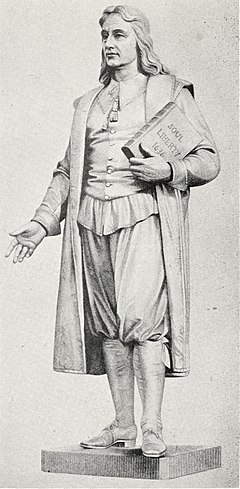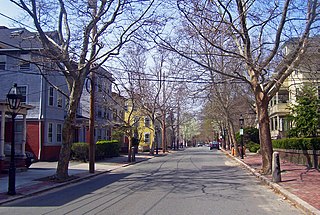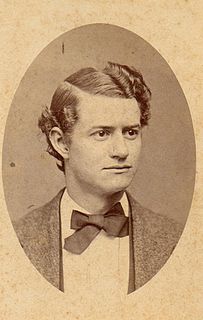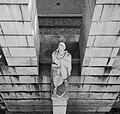
Roger Williams was a Puritan minister, theologian, and author who founded Providence Plantations, which became the Colony of Rhode Island. He was a staunch advocate for religious freedom, separation of church and state, and fair dealings with American Indians, and he was one of the first abolitionists.

Cranston, once known as Pawtuxet, is a city in Providence County, Rhode Island, United States. The official population of the city is 80,559, making it the third largest in the state. The center of population of Rhode Island is located in Cranston. Cranston is a part of the Providence metropolitan area.

The First Baptist Church in America is the First Baptist Church of Providence, Rhode Island, also known as the First Baptist Meetinghouse. It is the oldest Baptist church congregation in the United States, founded in 1638 by Roger Williams in Providence, Rhode Island. The present church building was erected in 1774–75 and held its first meetings in May 1775. It is located at 75 North Main Street in Providence's College Hill neighborhood. It was designated as a National Historic Landmark in 1960.

Leo Friedlander was an American sculptor, who has made several prominent works. Friedlander studied at the Art Students League in New York City, the Ecole des Beaux Arts in Brussels and Paris, and the American Academy in Rome. He was an assistant to the sculptor Paul Manship and taught at the American Academy in Rome and at New York University, where he headed the sculpture department. He was also president of the National Sculpture Society. In 1936, he was elected into the National Academy of Design as an Associate member, and became a full Academician in 1949.

Roger Williams Park is an elaborately landscaped 427-acre (173 ha) city park in Providence, Rhode Island and a historic district listed on the National Register of Historic Places. It is named after Roger Williams, the founder of the city of Providence and the primary founder of the state of Rhode Island.

College Hill is a neighborhood in Providence, Rhode Island, and one of six neighborhoods comprising the East Side of Providence and part of the College Hill Historic District. It is roughly bounded by South and North Main Street to the west, Power Street to the south, Governor Street and Arlington Avenue to the east and Olney Street to the north. College Hill is also home to Thayer Street, a shopping strip frequented by students in the Providence area.

The East Side is a collection of neighborhoods in the eastern part of the city of Providence, Rhode Island. It officially comprises the neighborhoods of Blackstone, Hope, Mount Hope, College Hill, Wayland, and Fox Point.

Burnside Park is a small park situated in downtown Providence, Rhode Island, adjacent to Kennedy Plaza. Named for Ambrose Burnside, a general in the American Civil War from Rhode Island, an equestrian statue was erected in his honor in the late 19th century, and sits in the center of the park.

Downtown is the central economic, political, and cultural district of the city of Providence, Rhode Island. It is bounded on the east by Canal Street and the Providence River, to the north by Smith Street, to the west by Interstate 95, and to the south by Henderson Street. I-95 serves as a physical barrier between the city's commercial core and neighborhoods of Federal Hill, West End, and Upper South Providence. Most of the downtown is listed on the National Register of Historic Places as the Downtown Providence Historic District.

The Fleur-de-Lys Studios, also known as Fleur-de-Lis Studios or Sydney Burleigh Studio, is a historic art studio, and an important structure in the development of the Arts and Crafts Movement in the United States. It is located at 7 Thomas Street in the College Hill neighborhood of Providence, Rhode Island. It was designed by Sydney Burleigh and Edmund R. Willson, and built in 1885. It was declared a National Historic Landmark in 1992.

The College Hill Historic District is located on the East Side of Providence, Rhode Island, United States. It was designated a National Historic Landmark District on December 30, 1970. The College Hill local historic district, established in 1960, partially overlaps the national landmark district. Properties within the local historic district are regulated by the city's historic district zoning ordinance, and cannot be altered without approval from the Providence Historic District Commission.

See also Daggett House, Slater Park, Pawtucket RI, built about the same time, by Nathaniel's father John.

Columbus was an historic statue in Providence, Rhode Island, United States on Elmwood Avenue in Columbus Square. Columbus is a bronze cast of a sterling silver statue which was created by Rhode Island's Gorham Manufacturing Company for the 1892 Columbian Exposition in Chicago. The original silver statue was not meant for permanent exhibition, but rather as a demonstration of the skills of the Gorham Company, and was later melted down. The bronze cast was dedicated November 8, 1893 as a gift from the Elmwood Association to the City of Providence. The statue was created in 1893 by Frédéric Auguste Bartholdi and added to the National Register of Historic Places in 2001. It was removed in 2020 by the City of Providence.

The Broadway–Armory Historic District is a historic district encompassing a mainly residential mixed-used urban area west of downtown Providence, Rhode Island.

Providence is the capital and most populous city of the state of Rhode Island and is one of the oldest cities in the United States. It was founded in 1636 by Roger Williams, a Reformed Baptist theologian and religious exile from the Massachusetts Bay Colony. He named the area in honor of "God's merciful Providence" which he believed was responsible for revealing such a haven for him and his followers. The city is situated at the mouth of the Providence River at the head of Narragansett Bay.

Alfred E. Stone was an American Architect. He was a founding partner of the Providence, Rhode Island, firm of Stone, Carpenter & Willson. Mr. Stone was best known for designing many prominent Rhode Island buildings, including the Providence Public Library, Union Station, buildings at Brown University and the University of Rhode Island, and many private homes.
The following is a timeline of the history of the city of Providence, Rhode Island, United States.
The Rhode Island International Horror Film Festival is an annual film festival held in Providence, Rhode Island, which features a wide variety of horror, sci-fi, and thriller films, as well as documentaries, from the United States and around the world. Founded in 2000, as one of several "festival sidebars" of the Rhode Island International Film Festival, it is the largest and longest-running horror film festival in New England.

James C. Bucklin (1801-1890) was an American architect working in Providence, Rhode Island.

Mashapaug Pond is the largest freshwater pond in the city of Providence, Rhode Island. Over the past four hundred years, Mashapaug Pond has been a site of indigenous settlement and displacement, deforestation and agriculture, urban and industrial development, remediation and activism. The pond was a significant site to Indigenous people for centuries before and after 1636, when the Europeans settled in Rhode Island. After King Philip's War a large number of the Narragansett people were either killed or driven out of the region. One of the small surviving communities happened to be the native community at Mashapaug, which transformed into the West Elmwood neighborhood. Over the next couple of centuries, the West Elmwood neighborhood became the city's first racially integrated neighborhood. In the 1960s, the redevelopment agency of Providence partook in the nation's claimed that areas around Mashapaug Pond, including the West Elmwood neighborhood, was blighted and substandard. As a result, the West Elmwood neighborhood was eliminated and the area surrounding Mashapaug Pond was renamed the Reservoir neighborhood. During the 19th century, the Gorham Manufacturing Company built its 37-acre plant on the shore of the pond. From 1890-1967 Gorham played a vital role in the development of the city of Providence and of the American decorative arts but also poisoned Mashapaug Pond. Today, due to surface water run-off and industrial discharges, Mashapaug Pond is extremely toxic. The former Gorham location, which includes the pond's cove, are contaminated with toxic metals, solvents and combustion waste products. In the 1960s In an effort to raise awareness about the pond and its condition, a nonprofit called the Urban Pond Procession was established. UPP Arts used the arts and the humanities to advocate for environmental issues in Rhode Island and particularly in Mashapaug Pond.





























